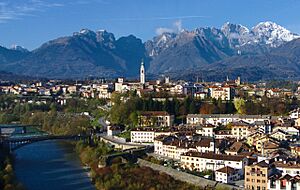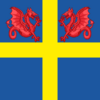Belluno facts for kids
Quick facts for kids
Belluno
|
|||
|---|---|---|---|
| Città di Belluno | |||

Panorama of Belluno
|
|||
|
|||
| Country | Italy | ||
| Region | Veneto | ||
| Province | Belluno (BL) | ||
| Frazioni | see list | ||
| Area | |||
| • Total | 147.18 km2 (56.83 sq mi) | ||
| Elevation | 390 m (1,280 ft) | ||
| Population
(January 2017)
|
|||
| • Total | 35,876 | ||
| • Density | 243.756/km2 (631.325/sq mi) | ||
| Demonym(s) | Bellunesi | ||
| Time zone | UTC+1 (CET) | ||
| • Summer (DST) | UTC+2 (CEST) | ||
| Postal code |
32100
|
||
| Dialing code | 0437 | ||
| Patron saint | Saint Martin | ||
| Saint day | 11 November | ||
Belluno is a town and a province in the Veneto region of northern Italy. It's about 100 kilometers (62 miles) north of Venice. Belluno is the main city of its province and an important place in the Eastern Dolomites mountains. About 36,000 people live here, making it the biggest town in the Valbelluna area. It's also one of the 15 towns that are part of the Dolomiti Bellunesi National Park.
Contents
Exploring Belluno's Location
Belluno is an old city built on a high cliff. It sits where the Torrente Ardo stream meets the Piave River.
Mountains Around Belluno
To the north, you can see the huge Schiara mountains, which are part of the Dolomites. Famous peaks like the Gusela del Vescovà (which means "Bishopric's needle"), Serva, and Talvena rise above the city.
South of Belluno are the Venetian Prealps. These mountains separate the city from the flat Venetian Plain. The Nevegal area, also to the south, is a popular place for skiing.
A Look at Belluno's Past
The name Belluno comes from an old Celtic word, belo-dunum, which means "shining hill."
Early History and Roman Times
It's thought that the first people in this area were mostly Venetic, with some Celts. As the Romans expanded north, the Celts either moved away or joined the Roman way of life. The people of Belluno became friends with Rome around 225 BC. They helped Rome during conflicts with the Gauls and when Hannibal invaded during the Second Punic War.
Belluno was likely founded between 220 and 200 BC. At first, Rome's influence was mostly about military protection and trade. The town was important for guarding cities to the south. Belluno also supplied valuable iron and copper. By the 2nd century BC, Belluno officially became part of the Roman Republic.
Later, Belluno became a Roman municipium, which was like a self-governing town. Its citizens were part of the Roman tribe Papiria. The town was managed by local officials and a council of elders. Under Emperor Augustus, Belluno was part of the "Venetia et Histria" region. You can still see a 3rd-century stone coffin near the church of San Stefano, belonging to a Roman citizen named Caius Flavius Hostilius and his wife.
From Middle Ages to Italian Unification
After the Western Roman Empire fell, Belluno was ruled by the Lombards (in the 6th century) and then the Carolingians (in the 8th century). A famous collection of treasures from this time, called the Belluno Treasure, is now in the British Museum.
From the late 800s, a count-bishop ruled Belluno, and the town got a castle and protective walls. After many disagreements with nearby Treviso, Belluno joined the powerful Republic of Venice in 1404. From then on, the city was a key place for moving lumber from the Cadore region down the Piave River. Belluno stayed part of Venice until 1797.
After the Venetian Republic fell, Belluno was controlled by Austria. Finally, in 1866, it became part of the new Kingdom of Italy.
In 1873, a strong earthquake damaged the cathedral and much of the town. However, the bell tower remained standing.
Must-See Places in Belluno
Belluno has many interesting old buildings and churches to visit.
- The Duomo (Cathedral, built in the 1500s), with its tall bell tower from the 1700s designed by Filippo Juvarra.
- Palazzo dei Rettori (built in 1491).
- The red Communal Palace.
- The Bishop's Palace, built in 1190.
- The Fountain in Piazza del Duomo.
- The Baroque church of San Pietro (originally Gothic, built in 1326). It has five paintings by Andrea Schiavone and three by Sebastiano Ricci.
- Palazzo del Capitano.
- The 16th-century church of San Rocco.
- Santo Stefano church, which has several 15th-century paintings by local artists. It also has an Adoration of the Magi from Tiziano's workshop.
- The Romanesque church of San Biagio.
- Porta Dojona and Porta Rugo: these are old gates in the city's ancient walls.
- Santa Maria dei Battuti: a church from the 1500s.
Belluno's Villages and Neighborhoods
Frazioni
These are smaller villages or areas that are part of the Belluno municipality:
- Antole
- Bes
- Bolzano Bellunese
- Caleipo-Sossai
- Castion
- Castoi
- Cavessago
- Cavarzano
- Cet
- Chiesurazza
- Cirvoi
- Col di Piana
- Col di Salce
- Collungo
- Cusighe
- Faverga
- Fiammoi
- Giamosa
- Giazzoi
- Levego
- Madeago
- Miér
- Nevegal
- Orzes
- Pedeserva
- Pra de Luni
- Rivamaor
- Safforze
- Sala
- Salce
- San Pietro in Campo
- Sargnano
- Sois
- Sopracroda
- Sossai
- Tassei
- Tisoi
- Vezzano
- Vignole
- Visome
Quarters
These are the main neighborhoods within Belluno city:
- Baldenich
- Borgo Garibaldi (or Via Garibaldi)
- Borgo Piave
- Borgo Prà
- Cavarzano
- Lambioi
- Mussoi
- Quartier Cadore
- San Lorenzo
- San Pellegrino
- San Francesco
- Via Cairoli
- Via Feltre-Maraga
- Via Montegrappa
Belluno's Climate
Belluno has a climate with warm summers and cold winters. The average temperature each year is about 10.8°C (51.4°F). The city gets about 1128 mm (44.4 inches) of rain each year.
| Climate data for Belluno, Italy | |||||||||||||
|---|---|---|---|---|---|---|---|---|---|---|---|---|---|
| Month | Jan | Feb | Mar | Apr | May | Jun | Jul | Aug | Sep | Oct | Nov | Dec | Year |
| Mean daily maximum °C (°F) | 3.3 (37.9) |
6.2 (43.2) |
11.1 (52.0) |
15.5 (59.9) |
19.9 (67.8) |
24.0 (75.2) |
26.5 (79.7) |
26.0 (78.8) |
22.4 (72.3) |
16.3 (61.3) |
9.6 (49.3) |
4.5 (40.1) |
15.4 (59.8) |
| Daily mean °C (°F) | −0.4 (31.3) |
1.9 (35.4) |
6.5 (43.7) |
10.7 (51.3) |
14.9 (58.8) |
18.7 (65.7) |
20.9 (69.6) |
20.5 (68.9) |
17.3 (63.1) |
11.8 (53.2) |
5.9 (42.6) |
1.2 (34.2) |
10.8 (51.5) |
| Mean daily minimum °C (°F) | −4.1 (24.6) |
−2.4 (27.7) |
1.8 (35.2) |
5.9 (42.6) |
9.9 (49.8) |
13.4 (56.1) |
15.3 (59.5) |
14.9 (58.8) |
12.2 (54.0) |
7.3 (45.1) |
2.1 (35.8) |
−2.2 (28.0) |
6.2 (43.1) |
| Average precipitation mm (inches) | 45 (1.8) |
52 (2.0) |
77 (3.0) |
97 (3.8) |
130 (5.1) |
120 (4.7) |
115 (4.5) |
102 (4.0) |
98 (3.9) |
116 (4.6) |
105 (4.1) |
71 (2.8) |
1,128 (44.3) |
| Average precipitation days | 5 | 5 | 7 | 11 | 13 | 13 | 11 | 10 | 8 | 9 | 8 | 6 | 106 |
| Source: Enea | |||||||||||||
Getting Around Belluno
State roads connect Belluno to other towns like Feltre, Treviso, Ponte nelle Alpi, and Vittorio Veneto.
Train and Bus Stations
The Belluno railway station is located at Piazzale della Stazione. It's part of the railway line that goes from Calalzo to Padua. The current station opened in 1912, replacing an older one. Its main building was designed in 1928 by architect Roberto Narducci.
The bus station is also right next to the railway station, making it easy to travel by bus.
Famous People from Belluno
Many notable people have connections to Belluno:
- Marco Paolini (born 1956), a stage actor.
- Dino Buzzati (1906–1972), a novelist and journalist born in Belluno.
- Pope Gregory XVI (1765–1846).
- Andrea Brustolon (1662–1732), a sculptor.
- Ippolito Caffi (1809–1866), a painter.
- Sebastiano Ricci (1659–1734), a painter.
- Marco Ricci (1676–1730), a painter.
- Luigi Luca Cavalli-Sforza (1922–2018), a human geneticist who lived and passed away in Belluno.
- Pope John Paul I (1912–1978).
- Bernardino Vitulini, a painter.
- Charles DeRudio, an Italian aristocrat who later became an American soldier. He fought in the 7th U.S. Cavalry at the Battle of the Little Bighorn.
Belluno's International Connections
Belluno is twinned with these cities:
 Cervia, Italy
Cervia, Italy Bend, United States
Bend, United States
Images for kids
See also
 In Spanish: Belluno para niños
In Spanish: Belluno para niños





